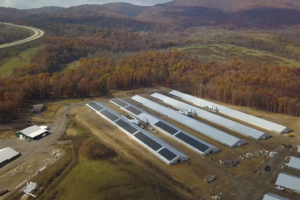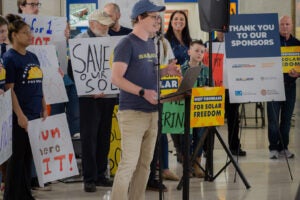A few weeks ago, Ohio based AEP released their Q3 Earnings Report where they shattered records with nearly $1 BILLION in profit. In just three months, they made 16,782 times more than most West Virginian families bring home in an entire year. And yet, last summer they found it necessary to ask the West Virginia Public Service Commission to raise our utility bills by another $250 Million. Simultaneously, they pushed the PSC to cheat solar producers out of fair compensation for the excess energy they send onto the grid by stripping the value of net metering a full 70% – a change that would have made solar unattainable for most of us. And that low key aimed to hurt homegrown businesses like Solar Holler.
Turns out, their arguments were flimsy. On the net metering front, without a cost shift analysis or a value of solar study, they had no data to support their claim that solar owned by you should be valued at rates lower than energy produced by them. Meanwhile, more and more reports indicate that the value of distributed solar is actually greater than that of utility supplied power.
Turns out, their work was also lazy. Interveners in the case, including Solar Holler, continuously pointed out flaws in their logic and errors in their math. They were dismissive of the 5,000 + voices who spoke out against them and of the concerns raised around their poor customer service, misbillings, and wrongly programmed meters. It was almost as if they didn’t quite grasp (or perhaps appreciate) the gravity of what they were proposing on the backs of West Virginians, on top of the burdens we already bear as AEP customers in a monopoly utility state where rates are rapidly rising.
Ultimately, the West Virginia Public Service Commission approved a more conservative rate increase of $76 Million (by the way, that’s 1,312 times more than most of us make in a year). They also ruled to follow precedent set in last year’s similar FirstEnergy case which bases the value of solar on actual avoided costs. It’s a more reasonable approach for sure, but still strips 27% of the value away from families who invest in solar in the future.
To put some numbers behind that, take a look at John Doe’s solar system (real customer, fake name). John’s solar will save him an estimated $70,726 over the next 25 years, because he’ll be grandfathered into the full retail net metering rate. Had John missed the deadline, that same system, producing the same amount of power under the new rate structure, would save him $58,128 in a 25 year span. A difference of more than $12,000!
Which brings us to the present moment.
The nugget of good news and what AEP customers need to know is that the solar policy change hasn’t happened yet! Those who file an application in the next three months and complete their installation by summer will be grandfathered into the current, far more generous retail net metering rate, for the next 25 years. Given that utility rates statewide have risen 34% in the last 5 years alone, and are predicted to increase far more in the years ahead, this is a boat that many of us just can’t afford to miss. The question is no longer, “how can you afford to go solar”. It’s, “how can you afford not to”.
Not only does solar offer predictable, fixed rates with no upfront cost, it’s also a path to energy independence and insulation from AEP’s next $ Billion quarter.
It doesn’t take long to see what you can save with solar and it’s free to find out, but we’ve set a deadline of December 12, 2025 here at Solar Holler. We need a few weeks to get your project prepped and permitted. Plus, it’s the Hollerdays! So we need to know that you’re in by December 12th in order to complete your project ahead of the changes. If you’re ready to be done with AEP’s nonsense, get started on a free solar analysis for your home today. Enter your info into the form on this page or click here to see numbers for your home.





